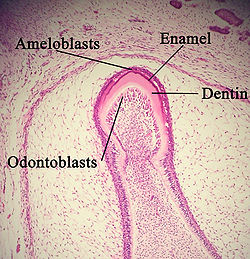Ameloblastic fibroma

Editor-In-Chief: Prab R Tumpati, MD
Obesity, Sleep & Internal medicine
Founder, WikiMD Wellnesspedia &
W8MD medical weight loss NYC and sleep center NYC
| Ameloblastic fibroma | |
|---|---|

| |
| Synonyms | |
| Pronounce | N/A |
| Specialty | Dentistry, Oral and maxillofacial surgery |
| Symptoms | Swelling, pain, delayed tooth eruption |
| Complications | N/A |
| Onset | Usually in the first two decades of life |
| Duration | |
| Types | |
| Causes | Unknown |
| Risks | |
| Diagnosis | Histopathology, Radiography |
| Differential diagnosis | Ameloblastoma, Odontogenic myxoma, Odontoma |
| Prevention | |
| Treatment | Surgical excision |
| Medication | |
| Prognosis | Good with complete excision |
| Frequency | Rare |
| Deaths | |
A rare benign odontogenic tumor
Ameloblastic Fibroma[edit]

Ameloblastic fibroma is a rare, benign odontogenic tumor that arises from the odontogenic epithelium and the mesenchymal tissue of the tooth germ. It is characterized by the proliferation of both epithelial and mesenchymal components, which distinguishes it from other odontogenic tumors.
Clinical Presentation[edit]
Ameloblastic fibromas typically present as a painless swelling in the jaw, often discovered incidentally on radiographs. They are most commonly found in the posterior region of the mandible, although they can also occur in the maxilla. The condition is more prevalent in children and young adults, with a slight male predominance.
Radiographic Features[edit]
On radiographic examination, ameloblastic fibromas appear as well-defined radiolucent lesions. They may be unilocular or multilocular, and the borders are often corticated. The lesion can cause displacement of adjacent teeth and may be associated with an unerupted tooth.
Histopathology[edit]
Histologically, ameloblastic fibromas consist of strands and islands of odontogenic epithelium resembling the ameloblastoma, set within a cellular mesenchymal stroma that resembles the dental papilla. The epithelial component may form structures similar to the enamel organ, but without enamel formation.
Treatment[edit]
The treatment of choice for ameloblastic fibroma is surgical excision. Due to the potential for recurrence, complete removal with a margin of healthy tissue is recommended. In some cases, more aggressive surgical approaches may be necessary to prevent recurrence.
Prognosis[edit]
The prognosis for ameloblastic fibroma is generally good, with a low rate of malignant transformation. However, there is a risk of recurrence if the lesion is not completely excised. Long-term follow-up is advised to monitor for any signs of recurrence or malignant transformation into an ameloblastic fibrosarcoma.
See Also[edit]
Ad. Transform your life with W8MD's Budget GLP-1 injections from $75


W8MD offers a medical weight loss program to lose weight in Philadelphia. Our physician-supervised medical weight loss provides:
- Weight loss injections in NYC (generic and brand names):
- Zepbound / Mounjaro, Wegovy / Ozempic, Saxenda
- Most insurances accepted or discounted self-pay rates. We will obtain insurance prior authorizations if needed.
- Generic GLP1 weight loss injections from $75 for the starting dose.
- Also offer prescription weight loss medications including Phentermine, Qsymia, Diethylpropion, Contrave etc.
NYC weight loss doctor appointmentsNYC weight loss doctor appointments
Start your NYC weight loss journey today at our NYC medical weight loss and Philadelphia medical weight loss clinics.
- Call 718-946-5500 to lose weight in NYC or for medical weight loss in Philadelphia 215-676-2334.
- Tags:NYC medical weight loss, Philadelphia lose weight Zepbound NYC, Budget GLP1 weight loss injections, Wegovy Philadelphia, Wegovy NYC, Philadelphia medical weight loss, Brookly weight loss and Wegovy NYC
|
WikiMD's Wellness Encyclopedia |
| Let Food Be Thy Medicine Medicine Thy Food - Hippocrates |
Medical Disclaimer: WikiMD is not a substitute for professional medical advice. The information on WikiMD is provided as an information resource only, may be incorrect, outdated or misleading, and is not to be used or relied on for any diagnostic or treatment purposes. Please consult your health care provider before making any healthcare decisions or for guidance about a specific medical condition. WikiMD expressly disclaims responsibility, and shall have no liability, for any damages, loss, injury, or liability whatsoever suffered as a result of your reliance on the information contained in this site. By visiting this site you agree to the foregoing terms and conditions, which may from time to time be changed or supplemented by WikiMD. If you do not agree to the foregoing terms and conditions, you should not enter or use this site. See full disclaimer.
Credits:Most images are courtesy of Wikimedia commons, and templates, categories Wikipedia, licensed under CC BY SA or similar.
Translate this page: - East Asian
中文,
日本,
한국어,
South Asian
हिन्दी,
தமிழ்,
తెలుగు,
Urdu,
ಕನ್ನಡ,
Southeast Asian
Indonesian,
Vietnamese,
Thai,
မြန်မာဘာသာ,
বাংলা
European
español,
Deutsch,
français,
Greek,
português do Brasil,
polski,
română,
русский,
Nederlands,
norsk,
svenska,
suomi,
Italian
Middle Eastern & African
عربى,
Turkish,
Persian,
Hebrew,
Afrikaans,
isiZulu,
Kiswahili,
Other
Bulgarian,
Hungarian,
Czech,
Swedish,
മലയാളം,
मराठी,
ਪੰਜਾਬੀ,
ગુજરાતી,
Portuguese,
Ukrainian